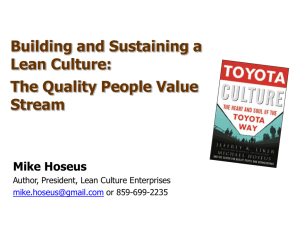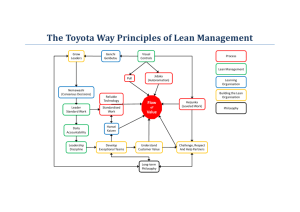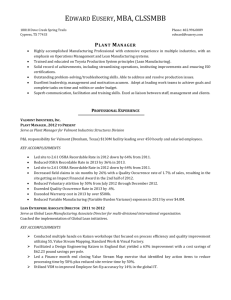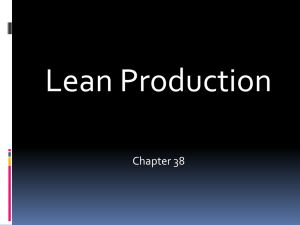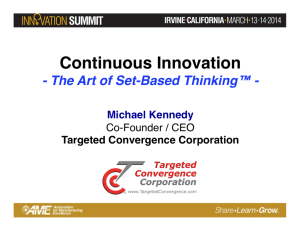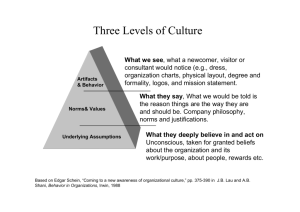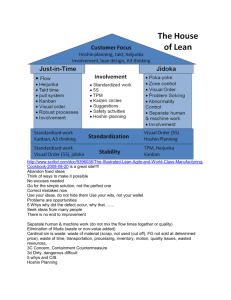Benchmark-Toyota Way
advertisement
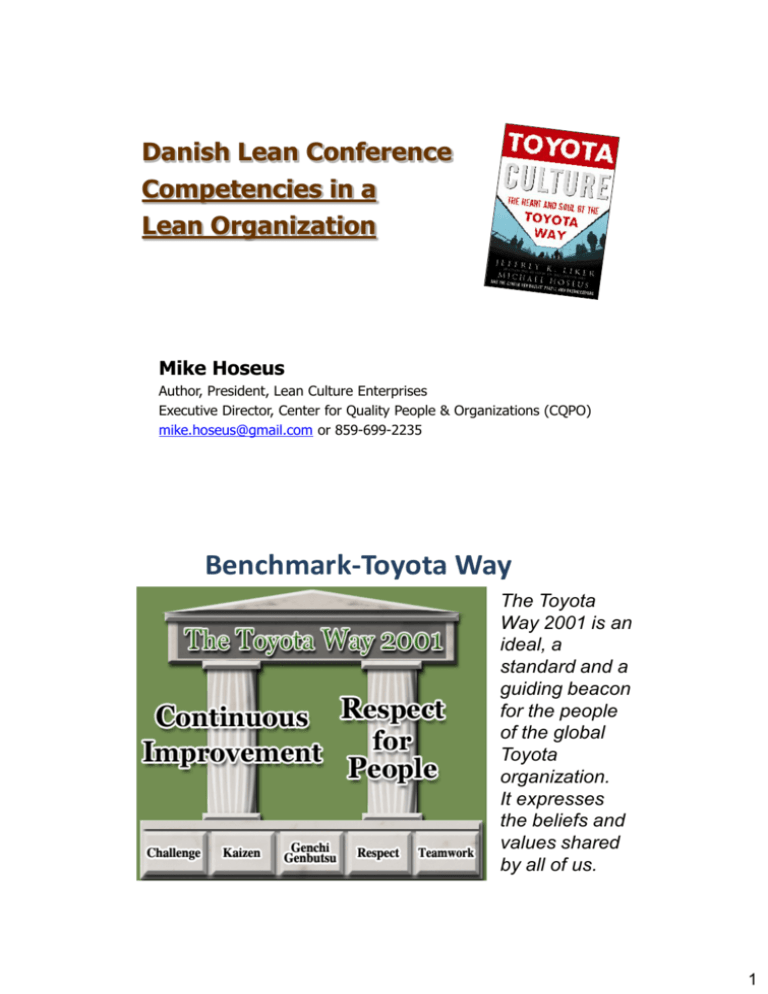
Danish Lean Conference Competencies in a Lean Organization Mike Hoseus Author, President, Lean Culture Enterprises Executive Director, Center for Quality People & Organizations (CQPO) mike.hoseus@gmail.com or 859-699-2235 Benchmark-Toyota Way The Toyota Way 2001 is an ideal, a standard and a guiding beacon for the people of the global Toyota organization. It expresses the beliefs and values shared by all of us. 1 Lean System Create Flow (Act) Evaluate Results (Check) Eliminate Waste Surface Problems (Plan) Countermeasures (Do) Quality People Create Competitive Advantage Competitive Advantage and Mutual Prosperity Quality People Supporting Systems Strong Culture 2 Principal Roles – For ALL “The Lean Management System” 1. Go and See: Understand the real situation, the real process, from the real people who work it, at the real place of action. 2. Define Normal Conditions Is the Current Condition (ab)Normal? Prove it. Can you define (ab)Normal? Write it. Can you SEE (ab)Normal? Visual Management When is it (ab)Normal? Tracking Metrics 3. Solve a Problem Teach the METHOD for Problem Solving – get involvement. Implement Solutions / Permanent counter measures. 4. Sustain and Nurture the Processes/People Identifying Lean Core Competencies Thinking and Operational Abilities Grasp the Situation Problem Solving Process Management Company Business Perspective Development Operational and Technical Skills 3 Identifying Lean Core Competencies Leadership & Teamwork Abilities Coordinate and Communicate Collaborate and Cooperate Initiate and Influence Build and Maintain Relationships Selection “Funnel” Recruiting & Communication Resume/ Application Prescreening Interview Applicant Tracking Competency Assessment (tests / simulations) Structured Behavioral Interview Background Review/ Drug and Alcohol Screen Each step in the hiring funnel has evaluation content that should be checked for accuracy and consistenc y across 4 TMMNA President, Art Niimi Competencies Succession Planning Organizational Culture Individual Career Planning Selection (Content & Process) Promotion Competencies (Content Knowledge / Skills / & Process) Abilities / Motivations / Vision / Values / Business Strategy Compensation Performance Management Organizational Development 5 Competency Progression Map Investment in People Toyota believes the investment in the development of its human capital will return a yield that is far greater than the cost of the investment. 6 Sample TMMK New Hire Training Program 2008 2010 PHASE I: New Hire or Te mporary O verview: 2013 PHASE II: TMMK New Hire Each Step: Plan= Classroom Training Do= OJT/ Homework Action=Extend Assignment $$$ *Business Direction *STW III Check= Assess./ Evaluation *Ergonomics *Two Way Communicat. $$ Skills/Pay *External Hire *Catch-up *Final Problem Solving Demons trati on *Process Diagnostics *Conflict Resolution *STW II. *KPIÕs *Visual. Control *Meeting Facilitation *STW $ *Safety *Values *TPS Start 4/3/2006 *Teamwo rk *STW *QC Tools *PDCA *A-3 *Problem Solving Ready to Hire 2 years Grow-in Complete 5 years OJT/Production Experience Toyota Way Values Learning Exercise 7 Step-by-Step Progression to Stable Job Performance ID Fundamental Skills for a Class of jobs Train in Fundamental Skills off of Line (GPC) Continuously Improve Job & Job Instruction Job Breakdown to Work Elements fo r Specifi c Job Off-Line Skills Training Use Toyota Job Instruction (TJI) to Train Associate On-JobDevelopment Follow-up & Support until Masters Job Example Video Manual 8 Example Simulated Jobs Toyota Training and Development General Manager and VP Level Business Planning and Policy Deployment Tools: Hoshin Planning & Toyota Business Practice s (TBP) Manager Level Focus on Shop Floor and Systems Improvement. Tools: Visual Factory & TBP TBP Team Leader and Group Leader Manage Standardized Work, Process Improvement and Develop Problem Solving Skills. Tools: FM DS, TBP & OJD Team Member Focus on Fundamental Skills & Standardized Work Tools: Skills Training, Job Instruction, Standardized Work and 5-S 9 Lean Leader Model Based on Liker, The Toyota Way Bottom-Up Development Top-Down Directive Group Facilitator Builder of Learning Organizations “ You’re empowered” “Here is our purpose and direction. I will guide and coach” Bureaucratic Manager Task Master “Follow the Rules” “Here is what to do and how—do it” General Management Expertise In-Depth Understanding of Work THE OBJECTIVES OF STANDARDIZATION • • • • • • • • • • • • Reduce variability, increase predictability Enhance repeatability, confidence, consistency Clarify procedures Enhance communication Improve Problem Solving Set good discipline Develop awareness Establish “Problem Consciousness” Establish a basis for education and training Establish a baseline for performance Improve Quality, Safety, Delivery, Cost Provide the basis for Improvement 10 Problem Solving at all Levels •Policies •Annual Objectives •Improvement Plans •Cross Organizational Problem Solving •Process Improvement Supervisors & Team Leaders Top Management •Objectives & Budget Management •Management Directed Kaizen Operators Plant Manager & Manager •Daily Problem Solving •Standardized Work •Kaizen •5S Three Stages of Problem Solving Maintenance Kaizen Goal Kaizen “Raising” “Maintaining” “Reaching” •Problem Solving that results in getting to the goal. •Problem Solving that focuses on maintaining the goal. New Goal •Problem Solving that focuses on increasing capability beyond the goal “Kaizen”. 11 Teams and Work Groups are Basic Units of Toyota Organization Inputs TM TM TM TM TM TM TM TM TM TM TM TM TM TM TM TM TM TM TM TM Safety Team Leader HR Team Leader Team Leader Team Leader Customer Value Quality TPS Maintenance Engineering Group Leader Ideal Span of Support 1:5 Visual Management System • A comprehensive system that aligns floor management and development activities to achieve company targets by: Aligning Hoshin shop floor activities with Hoshin goals/objectives Visually demonstrating: The management condition of the shop. Alignment of daily activities to Hoshin targets. Promoting two-way communication, creating the environment to: Address abnormal conditions through targeted problem solving. Determine needed support and resources. Develop team members. 12 Floor Management System Components Effective Shop Floor Management Team Member Skill Development Focuses on building an effective visual management system to help the group achieve Hoshin targets. Activities and tools to help develop team members capabilities to perform Standardized Work and achieve daily production goals with safety and quality. Team Board-Floor Management Development System 13 Quality Section of Team Board for Floor Management Development System Result Check ・Intervals ・Entire Company ・Individual Day Week Sr. Mgmt Dept Mgmt Subsection Group Individual Months Hoshin Review- PDCA Cycle 1 6 12 Process Check Grasping the gap between the daily plan and actual performance 14 Long Term Focus Develop People Deepen ability for problem solving and kaizen Create greater levels of discipline (establish process) The Real Purpose of the Process Short- Term Long- Term Simultaneous Objectives! 15 Fujio Cho, Chairman, Toyota Motor Former President, Toyota Motor Manufacturing, Kentucky: 3 Keys to Lean Leadership: 1. Go See. • “Sr. Mgmt. must spend plant floor.” time on the 2. Ask Why. • “Use the ‘Why?’ technique daily.” 3. Show Respect. • “Respect your people.” 31 Summary Connecting the “Product and the People” Value Streams • Lean can only be effective with both. • Lean implementation is accelerated with simultaneous development of both, saving cost. • Lean is sustained and continuously improved with both, increasing the payback on investment. 16
